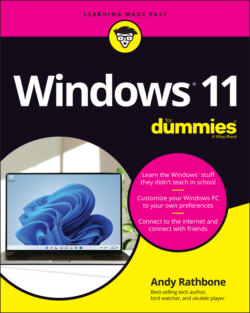Читать книгу Windows 11 For Dummies - Andy Rathbone - Страница 55
Customizing the taskbar
ОглавлениеWindows offers a whirlwind of options for the lowly taskbar, letting you play with it in more ways than a strand of spaghetti and a fork.
And that’s especially important if you don’t care for the new Start menu: By stocking the taskbar with icons for oft-used programs, you can avoid unnecessary trips to the Start menu.
First, the taskbar comes preloaded with icons for five apps: the new Widgets app (breaking news headlines), File Explorer (your file browser), Microsoft Edge (the Windows 11 web browser), the Microsoft Store app (for downloading apps and programs), and the Mail app. All but the first four taskbar icons are movable, so feel free to drag them to any order you want.
You can add your own favorites to the taskbar, as well. When you spot a favored program’s icon on the Start menu, right-click the icon, and choose Pin To Taskbar from the next pop-up menu.
For even more customization, right-click a blank part of the taskbar and choose Taskbar Settings. The Taskbar page appears in the Settings app, as shown in Figure 3-10.
FIGURE 3-10: Right-click a blank portion of the taskbar and choose Taskbar Settings to customize the taskbar’s appearance and behavior.
Table 3-1 explains the most-used taskbar settings, as well as my recommendations for them.
TABLE 3-1 Most-Used Taskbar Settings
| Setting | My Recommendations |
|---|---|
| Taskbar items | These toggle switches let you add or remove the Search, Task View, and Widgets options. I read way too much news already, so I turn off the entire Widgets panel with a click of its toggle. |
| Taskbar Corner Icons | On and off toggle switches live here, designed mostly for touchscreens, that let you add icons for a digital pen and touchscreen keyboard. I keep these turned off on my desktop PC, but turned on on my tablets. |
| Taskbar Corner Overflow | Another bundle of toggle switches let you choose which tiny icons should appear on your taskbar’s far right edge, and which should be hidden, only to pop up when you click the little upward pointing arrow next to those icons. This is a personal choice, but I don’t like hidden icons, so I let them all show. |
| Taskbar Behaviors | I ignore this overwhelming number of toggles except for one: In Taskbar Alignment, I choose left, which moves the currently centered icons and Start button back to the left corner, where they’ve lived for years. |
Feel free to experiment with this section’s many toggle switches until the taskbar looks right for you. Your changes take place immediately. Don’t like the change, or don’t notice a big difference? Click the toggle switch again to reverse your decision.
Again, most of these toggles boil down to personal preference; there’s no standard right or wrong for everybody. People who run Windows 11 on very wide monitors often prefer seeing their taskbar icons centered rather than along the traditional left side.
